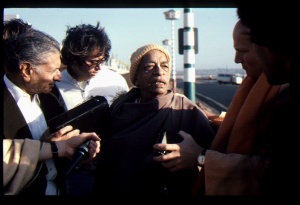CC Adi 12.87 (1975)

A.C. Bhaktivedanta Swami Prabhupada
Below is the 1996 edition text, ready to be substituted with the 1975 one using the compile form.
TEXT 87
- amogha paṇḍita, hasti-gopāla, caitanya-vallabha
- yadu gāṅguli āra maṅgala vaiṣṇava
SYNONYMS
amogha paṇḍita—Amogha Paṇḍita; hasti-gopāla—Hastigopāla; caitanya-vallabha—Caitanya-vallabha; yadu gāṅguli—Yadu Gāṅguli; āra—and; maṅgala vaiṣṇava—Maṅgala Vaiṣṇava.
TRANSLATION
The twenty-eighth branch was Amogha Paṇḍita; the twenty-ninth, Hastigopāla; the thirtieth, Caitanya-vallabha; the thirty-first, Yadu Gāṅguli; and the thirty-second, Maṅgala Vaiṣṇava.
PURPORT
Śrīla Bhaktisiddhānta Sarasvatī Ṭhākura writes in his Anubhāṣya, “Śrī Maṅgala Vaiṣṇava was a resident of the village Ṭiṭakaṇā in the district of Murśidābād. His forefathers were śāktas who worshiped the goddess Kirīṭeśvarī. It is said that Maṅgala Vaiṣṇava, formerly a staunch brahmacārī, left home and later married the daughter of his disciple Prāṇanātha Adhikārī in the village of Mayanāḍāla. The descendants of this family are known as the Ṭhākuras of Kāṅdaḍā, which is a village in the district of Burdwan near Katwa. Scattered descendants of Maṅgala Vaiṣṇava, thirty-six families altogether, still live there. Among the celebrated disciples of Maṅgala Ṭhākura are Prāṇanātha Adhikārī, Puruṣottama Cakravartī of the village of Kāṅdaḍā, and Nṛsiṁha-prasāda Mitra, whose family members are well-known mṛdaṅga players. Sudhākṛṣṇa Mitra and Nikuñjavihārī Mitra are both especially famous mṛdaṅga players. In the family of Puruṣottama Cakravartī there are famous persons like Kuñjavihārī Cakravartī and Rādhāvallabha Cakravartī, who now live in the district of Birbhum. They professionally recite songs from Caitanya-maṅgala. It is said that when Maṅgala Ṭhākura was constructing a road from Bengal to Jagannātha Purī, he found a Deity of Rādhāvallabha while digging a lake. At that time he was living in the locality of Kāṅdaḍā, in the village named Rāṇīpura. The śālagrāma-śilā personally worshiped by Maṅgala Ṭhākura still exists in the village of Kāṅdaḍā. A temple has been constructed there for the worship of Vṛndāvana-candra. Maṅgala Ṭhākura had three sons—Rādhikāprasāda, Gopīramaṇa and Śyāmakiśora. The descendants of these three sons are still living.”